April at the Falls
Pevans was at the 2014 Gathering of Friends
My report is written as a narrative to be read through and focuses on the new (to me) games I played, as well as the social side of the Gathering. You can use the indexes below to take you to specific sections or games.
It is also available as a PDF document: Gathering of Friends 2014 report (4.7 Mb). (You will need Adobe Reader to view this document – use the link to download it if necessary.)
- List of games
- Introduction – getting there
- Day 1 – From sailing ships to zombies
- Day 2 – From Russia to Istanbul, via Helios
- Day 3 – Splendid!
- Day 4 – Orchards and spaceships
- Day 5 – Wargames day
- Wrapping up and getting home
- About the Gathering
List of new (to me) games
| Title | Publisher/Distributor | Rating |
|---|---|---|
| Black Fleet | Space Cowboys | 9/10 |
| Bruxelles 1893 | Pearl Games/Z-Man Games | 6/10* |
| Castles (of Mad King Ludwig) | Bézier Games | 9/10* |
| Citrus | dlp games | 7/10* |
| Cuatro | Noris Spiele | 8/10* |
| Dark, Darker, Darkest | Queen Games | 5/10* |
| Funkenschlag/Power Grid 10th anniversary edition | 2F Spiele/Rio Grande Games | 10/10* |
| Gravwell | Cryptozoic Entertainment | 6/10* |
| Helios | Hans im Glück/Z-Man Games | 7/10 |
| Il Vecchio | H@ll Games/Tasty Minstrel Games | 7/10* |
| Istanbul | Pegasus Spiele | 8/10* |
| Nations | Lautapelit | 9/10* |
| Nauticus | Kosmos | 9/10 |
| North Wind/Norderwind | Z-Man Games/Kosmos | 8/10* |
| Russian Railroads | Hans im Glück, Z-Man et al | 7/10 |
| Splendor | Space Cowboys | 8/10* |
| Urbania | Mayfair Games | 7/10* |
| Xanadú | Azahar Juegos | 7/10* |
| * Provisional rating based on playing just once | ||
About the Gathering
This year’s event was the 25th Gathering of Friends, which started out as a weekend get-together by a bunch of gamers, led by Alan Moon (now well known as the designer of Airlines, Elfenland, Ticket to Ride et al). The following year they did it again, bringing some friends with them. This is the abiding principle of the Gathering of Friends: everybody who comes is a friend (and is invited by Alan). This makes for a very convivial, relaxed atmosphere in which anyone can walk up to anyone and ask to join or start a game. Never mind six degrees of separation; at the Gathering it’s hard to find anyone more than 2 degrees away!
Over the years, the Gathering has expanded in time and space: the 2014 event had close to 400 attendees over nine full days (though very few people were there for the whole time – the peak was probably 250-ish). It has moved, arriving in Niagara Falls in 2011 after several years in Columbus, Ohio. There is an increasing business element to the Gathering, as well. Games designers bring prototypes to test and show to the publishers who attend. However, the emphasis remains on playing games and having fun. The event would be recognisable to anyone who’s attended any gamer-organised convention in the UK. It consists of people playing games – most of which they’ve brought with them and made available to everyone else. I always have a good time.
Getting there
I’ve said before that attending any games convention usually involves some sort of transport problem. However, my journey to Niagara Falls went swimmingly. I got to Heathrow airport in good time. The plane ride was tedious, but uneventful. There were no delays in immigration at Boston airport. My connecting flight to Buffalo went well – I was even sitting next to Cathy Carroll, with whom I was sharing a ride to the hotel in Niagara Falls. At Buffalo airport, we met up with our other sharer and were ready to go. Except that there was no sign of my luggage. That was so close!
Apparently, my bag didn’t make the transfer between terminals in Boston in time, so wasn’t on the plane with me. This seems to be a common problem as the system for dealing with it ran smoothly: my bag was delivered to the hotel just before midnight. So, an on-time arrival in Niagara for the first time, but my luggage was 5 hours late.
Never mind, it was time for five (and a bit) days of playing games and chatting to friends, old and new, with a bit of eating and drinking thrown in. While I will talk a bit about the social side, my emphasis is the new (to me, at least) games I played. I’ll cover these in the order I played them, so there should be no discernible pattern to what follows.
My first evening (Monday) was spent saying hello to people and getting a bite to eat with some of them. Across the road from the hotel is a huge casino, which contains all sorts of eating places. They may allow smoking in the casino itself, but not in the restaurants. This time I was introduced to the all-you-can-eat-buffet food court. Lots of different cuisines that you can mix and match: pizza and samosa chow mein, anyone? By the time I got back to the hotel, I was falling asleep, so gaming was put off until the following day.
From sailing ships to zombies
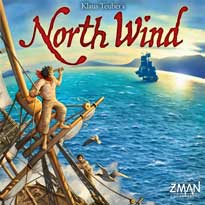 Tuesday started early – well, early for a games convention. My roommate and fellow Brit, Pete Card and I bumped into Kris Gould. It’s hard to miss him, his shirts are bright enough to be seen from space! Kris offered to introduce us to Norderwind and we roped in Jason Henke to make a fourth. Designed
by Klaus
Teuber, this
is one of this year’s titles from Kosmos, with Z-Man Games producing the English language version (as North Wind). The immediate appeal of the game, however, is in the ships
each player has.
A set of solid cardboard pieces fold and clip together to make the hull and deck of each player’s ship, with a mast that fits through both and a sail to hang off the mast. Cardboard cannon fit on the sides and the neat wooden pieces (crew, cargo) slot into gratings in the deck. It’s very clever and looks great.
Tuesday started early – well, early for a games convention. My roommate and fellow Brit, Pete Card and I bumped into Kris Gould. It’s hard to miss him, his shirts are bright enough to be seen from space! Kris offered to introduce us to Norderwind and we roped in Jason Henke to make a fourth. Designed
by Klaus
Teuber, this
is one of this year’s titles from Kosmos, with Z-Man Games producing the English language version (as North Wind). The immediate appeal of the game, however, is in the ships
each player has.
A set of solid cardboard pieces fold and clip together to make the hull and deck of each player’s ship, with a mast that fits through both and a sail to hang off the mast. Cardboard cannon fit on the sides and the neat wooden pieces (crew, cargo) slot into gratings in the deck. It’s very clever and looks great.
The heart of the game is a set of tiles that provide the actions for players. Piles of these are allocated to the several ports. In their turn, players turn over tiles and decide whether to action them until they have either actioned two or hit their limit on tile-turning. The tiles let players buy and sell goods, encounter pirates or upgrade their ship and there’s a neat consolation mechanism if a player doesn’t get their two actions. As you’d expect, there’s a balance between enhancing your position and scoring that you need to get right.
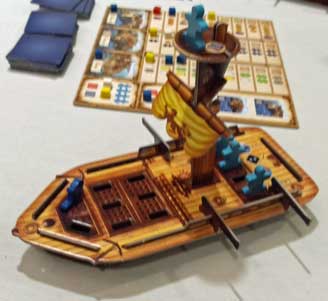
My North Wind ship: lots of crew and cannon, but no cargo… yet
North Wind is a neat, lightweight, trading game, with a dollop of luck and great pieces. It zips along at a decent pace and offers players the opportunity to minimise the luck element – or just go for it! It’s an excellent addition to the stable of Klaus Teuber games and I give it a provisional 8/10 on my highly subjective scale.
From pirates to pleasure domes: Jeff Baker enticed Pete and I to try Xanadú. Not that we needed much persuading as it looked intriguing. It’s a card game published by Azahar Juegos in Colombia and designed by Santiago Salazar, Carolina Tobar and Javier Velásquez. The idea of the game is that the players are architects, adding buildings to Kublai Khan’s stately pleasure dome. On the front, each card shows a building with its building costs, anything it produces and what it’s worth. On the back, each card is a worker, which you assign to a building to produce (notional) materials.
The obvious decision facing players is which buildings to build and which to forego so that they can be used as workers. While some buildings automatically provide materials, you will generally need to use some workers to get what you need to play a building. The clever bit is that each building can be used a number of times to produce materials, but this also changes its value. Once its production has all been used, it is removed and the owner gets any residual value.
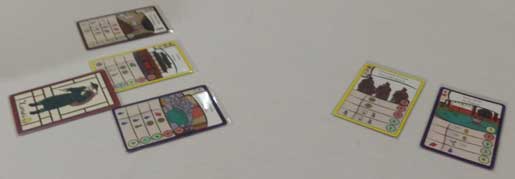
Playing Xanadú
However, the value of a building can go down or up as it is used and, to add to the fun, players can place workers on other players’ buildings. Other things being equal, if you have a nice, high value building in front of you, other players will use it to reduce its value. Conversely, nobody will go near the low value building you want to boost! Thus players must think hard about where to place workers: what materials they can produce – and how this matches the cards in their hand – and how this affects the values of the buildings. Xanadú is a clever game, but I found it rather slow (especially for first-time players) and a bit fussy (there are a lot of materials). It gets a provisional 7/10 on my highly subjective scale.
One of the games I’ve been wanting to play since it was launched at Spiel ’13 is Nations. Designed by Rustan and Nina Håkansson and Einar and Robert Rosén, it comes from Finnish publisher Lautapelit (and widely distributed by Asmodee) and was described to me as “Through the Ages lite”. I’m all for the full fat version, but a little bit of abstinence can’t hurt. Ed Bryan was the man teaching us the game and Pete and I were joined by an old Gathering friend, Dan Luxenberg.
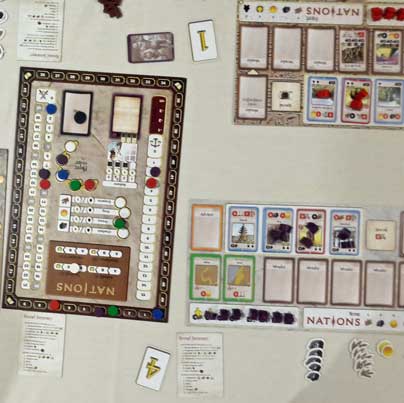
Playing Nations
The game is played over four Ages, each of two rounds. That’s just eight rounds for the rise (and fall?) of a civilisation. Luckily, players get to do a lot in each round. Each player has their own board with places for the various ‘Progress’ cards they will buy. Spaces for the different types of Progress card are limited, so cards will soon need to replace previous cards, changing what players produce and their ‘Military Strength’ and ‘Stability’. As you’d expect, you need the materials you produce to advance your civilisation and to build new things.
Crucial to the game, though, are your military strength and stability. The former allows you to survive wars and other events and compete with other players. The latter is needed to increase your population (providing more workers for production and the military), survive events and avoid civil unrest. Given the limited numbers of cards players can deploy (and the mix is different for each ‘nation’), there are hard decisions to be made all through the game.
Nations has some clear similarities to Through the Ages – and just about every other civilisation development game – but the game’s mechanisms and play are very different. I was very taken with the way development is handled with cards replacing existing ones and the limits on the active cards players can have. This is definitely a game I want to play more and I give it a provisional 9/10 on my highly subjective scale.
I was intrigued to find, the first time I visited, that Niagara Falls has a large Indian population. This means there are lots of Indian restaurants in the town and, best of all, several in easy walking distance of the hotel. Pete and I took Dan’s recommendation and joined him and his wife, Julie, for a pleasant evening of spicy food and entertaining chat.
On returning to the hotel, I bumped into more old Gathering friends, James and Sheila Davis. They were setting up Dark, Darker, Darkest, a co-operative game of fighting zombies, and were looking for more players. Pete and I joined them and Doug Hoover made it five. Designed by David Ausloos and published by Queen Games, this game has the players searching a building that’s both full of zombies and burning down. Apart from finding equipment to help them (weapons mainly), the players are seeking the components that will enable them to match the code that will get them into the laboratory that contains the antidote to the zombie plague. No pressure, then.
The game’s mechanisms keep generating zombies that attack the players and fire outbreaks that hinder their movement. The players need to destroy the zombies and put out the fires so that they can get round the building and find all the codes they need. Once into the laboratory, there is a whole sub-game that pits the players against their nemesis, who is behind the whole zombie plague. To win, the players must defeat the nemesis while keeping alive the character who has the antidote.

My Dark, Darker, Darkest character – I was actually more effective with the baseball bat than the automatic
As this description suggests, Dark, Darker, Darkest is a really tough game. While we had no trouble keeping the fires under control, the hordes of zombies prevented us from getting round the house and collecting the code elements we needed. Perhaps we should have split up! I had fun being, in effect, ‘Buffy the Zombie Slayer’, but the game felt like Flash Point: Fire Rescue with added zombies. Personally, I can do without the zombies, so this is a game I probably won’t be playing again. It gets a provisional 5/10 on my highly subjective scale.
From Russia to Istanbul, via Helios
Wednesday morning saw me explaining Russian Railroads to Pete Card and our old friends Leo Tischer and Mike Allen. As I’ve only played it once (at MidCon last year – see my report in TWJO 141), this was clearly a case of the one-eyed man being king. Luckily, a passing Tom DeMarco stepped in to teach it properly. To summarise the game, each player has their own board on which they build and upgrade railway lines and factories across Russia. Reaching specific points triggers rewards and upgrades. However, the actions players do each round depend on placing workers on the main board.
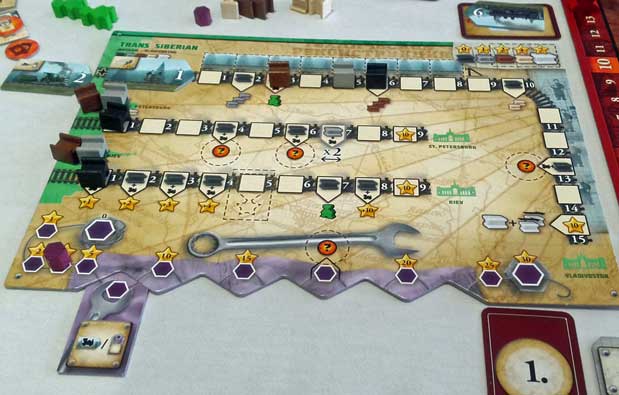
Early days for my Russian Railroads
Designed by Helmut Ohley and Leonhard Orgler and published by Hans im Glück (in German) and Z-Man (in English), Russian Railroads is a heavyweight ‘worker placement’ game. It’s exactly the sort of game that appeals to hobby gamers as it requires decision making and provides several strategies for winning. Our game was closely fought with Leo pipping me by two points on scores of 360-something. While I enjoy the game, it doesn’t grab and playing it for the second time confirms it as a solid 7/10 on my highly subjective scale.
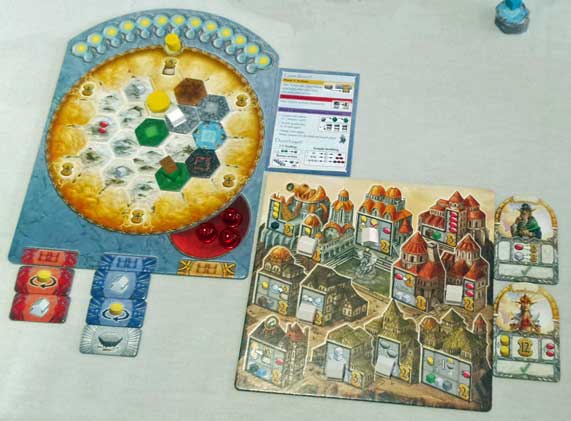
Playing Helios
The four of us then moved on to another Hans im Glück/Z-Man game, Helios, designed by Martin Kallenborn and Matthias Prinz. It was much in evidence at the Gathering – well, its bright yellow box is very noticeable. This time each player has two small boards in front of them. One shows the world they build up from hexagonal tiles and around which the sun orbits (no, really). The other is their city, showing the buildings they can construct and the bonus each building provides.
Players can do one of three actions in their turn: build a building, for which they need to have the correct resources; add a land tile to their world, while these are still available; and move their sun. The sun piece goes round the outside of the tiles that make up their world and ‘illuminates’ the tiles it ends up next to. These produce resources (or points). The heart of the game is right there: add tiles, produce resources, build buildings – not necessarily in that order.
There are some neat wrinkles on top of this. For example, each time a player takes an action, they also take a chit for that type of action. The chits limit the number of times that action can be taken. In addition, players get a bonus action when they gain four chits of the same colour (which is independent of type). Helios is a complicated, clever game of medium weight. I played it several times during the week, which confirmed that it’s a game I’m quite happy to play, but not one I’ll be suggesting. It gets 7/10 on my highly subjective scale.
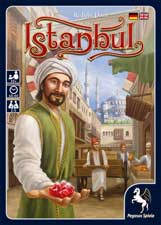 Later I joined Ken Hill, Ken Gutermuth and Craig Good to play Istanbul. This is one of the recent crop of games from Pegasus Spiele, in this case designed by Rüdiger Dorn, which gives it an interesting pedigree. The game is played over a board made up of rectangular tiles, each representing a different location
in the
city. There is a specific
set-up
when playing the game for the first time, but after that they can be set out randomly to give players different opportunities – and problems.
Later I joined Ken Hill, Ken Gutermuth and Craig Good to play Istanbul. This is one of the recent crop of games from Pegasus Spiele, in this case designed by Rüdiger Dorn, which gives it an interesting pedigree. The game is played over a board made up of rectangular tiles, each representing a different location
in the
city. There is a specific
set-up
when playing the game for the first time, but after that they can be set out randomly to give players different opportunities – and problems.
The players are merchants, buying and selling goods around the city. Of course, they also need to get from place to place and carry their goods with them. Thus, as well as buying and selling, the tiles allow players to move faster or carry more. In particular, there are rubies to buy or acquire at some tiles. The first player to get the right number of rubies wins the game.
There are some neat details on top of this. One I particularly like is that, as big-shot merchants, the players don’t wander round in person: they send their lackeys (or even their ne’er-do-well brother-in-law) to buy things. However, after a while, your servants are spread across the board and you must either spend time gathering them up or summon them all to the main square and start from there again.
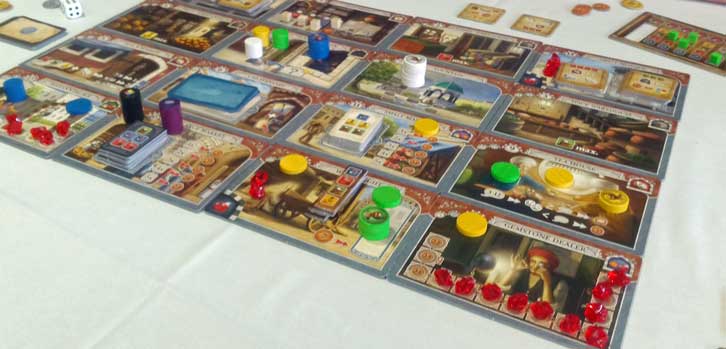
Istanbul in play: note the rubies waiting and players’ pieces getting spread about
I found Istanbul an interesting, medium weight trading game. It has some clever touches, but it felt quite abstract, despite the attractive Arabian theme. However, it’s a game I’d really like to play again, so I’m going to give it a provisional 8/10 on my highly subjective scale.
Last year some of us at the Gathering discovered the Niagara Falls Culinary Institute, which is in the city block just behind the hotel. This runs courses in cooking, baking, hospitality, restaurant management and other disciplines and has the facilities to match. To enable the students to strut their stuff, it also has a delicatessen, patisserie, wine merchant and … a fine dining restaurant. This year the Institute had laid on a programme of events for gathering attendees. I went for the fine dining option: a five-course tasting menu with complementary wines. I was not alone. There were 18 of us around the table, with other tables in the restaurant (including the chef’s table) occupied by gathering attendees.
The food was excellent, the wines generally ditto – though I found the wine made from native American grapes too musty. However, we were rudely interrupted just as the second course had been served by the fire alarms! We spent ten minutes in the chilly outdoors as two fire trucks, a ladder and a rescue van arrived, hung around and departed (possibly with take-away). The consensus was that someone in the kitchen probably failed their course! Once we had settled back at the table, the staff served the second course again (and presumably cooked a fresh batch of dishes). It was a fine, if lengthy evening and will no doubt be a fixture in the schedule from now on.
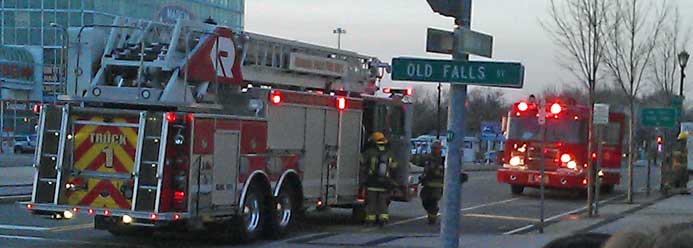
Niagara Falls’ firemen do their stuff
Splendid!
With my body clock still adjusting to US time, I realised that many of the people in the main room first thing in the morning were my fellow Europeans (the other thing we do is spend more time in the bar than most of the Americans). The European contingent included the one and only Friedemann Friese, main man of 2F Spiele and one of my favourite game designers. On Thursday morning he co-opted me, Pete and a token American (whose name I have failed to note) to play the (pre-production) 10th anniversary version of Funkenschlag/Power Grid.
Those of you who know the game will need no introduction and I’m sadly disappointed in anyone else – I consider the game to be a masterpiece. The game is about providing power to cities on the board. There is a clever auction of power station cards each round, then players purchase fuel and expand their network. Ideally you have the fuel to generate the power for all your cities, thus providing the income you need for the next round. It is a very clever game in which the elements dovetail together precisely.
The new edition benefits from ten years feedback and the experience of developing the numerous expansions. Garbage has been replaced by natural gas as a type of fuel, the power stations have been changed and a few other things tweaked. However, the major change is that the least valuable power station available to auction has a starting bid of one rather than face value. This small change has quite a big effect as managing your money is the key to success in Power Grid.
The new edition comes with a double-sided board with the USA on one side and Europe on the other. Both boards have seven regions, rather than the previous six, and the game is played on as many regions as there are players. This is another minor change that makes a difference. It will be published this October and launched at Spiel ’14 and I’m happy to give it at least 10/10 on my highly subjective scale. Friedemann will also have a new edition of Fresh Fish, which, he assures me, is less brain-burning than the original, while remaining just as clever. I look forward to it.
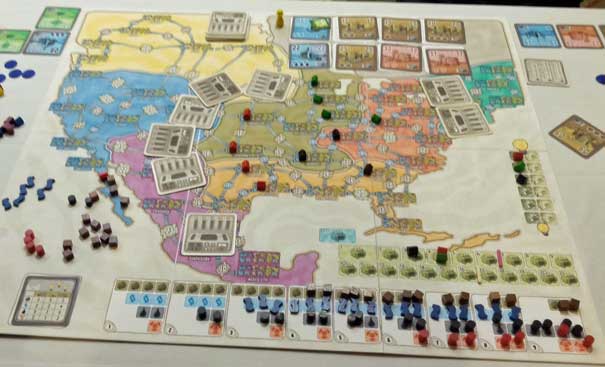
Early days for power generation in the USA in the new Power Grid (the cards on the board block off the sections we weren’t using)
In a departure from routine, Thursday saw a bunch of us head out for lunch. Our chauffeur was another old friend, Steve Lesnik, and our destination was the Griffon [sic] ‘gastro-pub’. Okay, it’s not much like a British pub, but it had decent food and a huge selection of American craft beers and exotic imports like Guinness and Fuller’s ESB. We tried tasting ‘slides’ of 6 ounce glasses and I worked my way through half a dozen from wheat beer to porter. Interestingly, they were all quite strong in alcohol terms.
Returning to the games, I mentioned that one of the games I wanted to play was Bruxelles 1893. A copy was quickly found and four of us embarked on a voyage of discovery. Launched at Spiel ’13, the game was designed by Etienne Espreman and published by Pearl Games (and Z-Man in the USA). The game has two very busy boards, one made up of strips of card so that it’s different each time you play. Players also have their own boards showing their progress towards various bonuses.
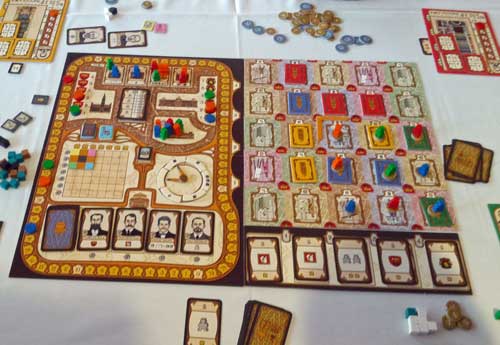
The two central boards of Bruxelles 1893
By placing pawns on one of the strips, players get to take the action shown on that space. The actions include taking materials, using materials to construct a building, creating a ‘work of art’, selling a work or gaining a patron. There are several neat mechanisms here. In particular, patrons are useful during the game, but are penalty points at the end. In addition, at the end of a round there’s a bonus for the player with the most pawns in a column and points for the players with most workers around each intersection between rows and columns.
The game lasts just five rounds and ends with a final scoring. What I’ve glossed over above is that there are lots of way of scoring points, as you’d expect in a game of this sort. As always, the trick is to get your points where the other players aren’t competing – though I’m sure that is tougher with players who know what they’re doing. Bruxelles 1893 is an intricate worker placement game. I’m glad to have played it and it’s a decent enough game, but I don’t think it’s one that I’ll be playing again. It gets a provisional 6/10 on my highly subjective scale.
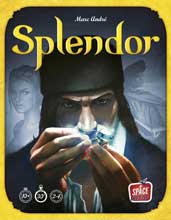 Later on Thursday evening I got to play what was probably the hit game of the convention, Splendor, designed by Marc André and published by Space Cowboys. The amiable Kevin Nunn did the teaching and Ann and Steve Lesnik were my fellow pupils. Essentially, this is a card game, though the other component is a set
of heavy
poker-style chips that
add a nice
tactile element to the game.
Later on Thursday evening I got to play what was probably the hit game of the convention, Splendor, designed by Marc André and published by Space Cowboys. The amiable Kevin Nunn did the teaching and Ann and Steve Lesnik were my fellow pupils. Essentially, this is a card game, though the other component is a set
of heavy
poker-style chips that
add a nice
tactile element to the game.
The brightly illustrated cards come in six different colours, representing different gems. Each card shows its cost (in gems), the gem it produces and its points value (if any). In their turn, players either pick up some chips (gems) or spend chips and ‘production’ buying a card to add to their set. They can also get bonus points by collecting ‘Noble’ cards if they have the right set of cards. First player to a set number of points wins.
Splendor is pretty simple, but it’s an appealing, quick-playing game with some subtlety. As the one person who’d played before, Kevin won our game – though the rest of us were not far behind. It’s a bit too abstract for my taste, but it makes a good filler and should appeal to non-gamers as well. I’ll give it a provisional 8/10 on my highly subjective scale.
Orchards and spaceships
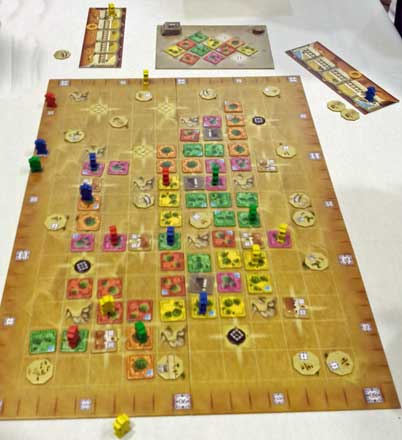
The patchwork of orchards takes shape in Citrus
Friday’s opener was another game from Spiel ’13 that I hadn’t played yet. Citrus is designed by Jeffrey Allers and published by dlp games, a small German publisher with an interesting selection of games. Gathering veteran Chuck Ledger introduced me to it, along with his wife, Peggy, and Craig Good. For once this is a game with a square grid on the board! The board starts pretty much empty, but is marked with positions where fincas (“estates” in Spanish but, in this context, fruit farms) will be placed. We start with a few of these and more are added as the game goes on.
Players’ tiles are orchards, in five colours (though two shades of orange was a bit confusing). First they buy tiles, taking a complete row from the display. Then they place these, marking their orchards with a worker pawn. There are very precise rules on what can be placed where: each finca must have a different colour orchard at each exit, for example, and orchards of the same colour belonging to different players cannot touch. When a finca is completely surrounded, it scores points. First, you identify the orchards adjacent to the finca. Then you count all the tiles in these orchards. The points go to the player with the most tiles.
Instead of buying and placing tiles, players can generate cash (and some points) by bringing a worker home, relinquishing control of an orchard. What’s more, you get more cash the more of your workers that are at home. This provides a major tactical decision for players: leave workers where they may score points and struggle without cash, or abandon points-scoring opportunities to get money.
Citrus is a clever game with some neat mechanisms and clearly has its fans (Chuck for one). It is, however, rather too abstract for my taste with a strong element of spatial awareness and went on a bit longer than I expected. I’d be happy to play it again, but it wouldn’t be my first choice. I give it a provisional 7/10 on my highly subjective scale.
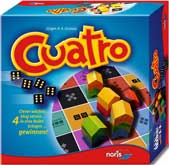 No sooner had I finished Citrus, than I was grabbed by the ever-friendly Greg Schloesser, new editor of Counter and another Gathering old-timer, to play Cuatro. Greg described this as Yahtzee meets Connect 4 and that’s exactly what it is! You roll the dice to make poker-like sets (three of a kind, straight, full house etc) which allow you to place
a marker
on an appropriate
space on the
board. Get four in a row and you win!
No sooner had I finished Citrus, than I was grabbed by the ever-friendly Greg Schloesser, new editor of Counter and another Gathering old-timer, to play Cuatro. Greg described this as Yahtzee meets Connect 4 and that’s exactly what it is! You roll the dice to make poker-like sets (three of a kind, straight, full house etc) which allow you to place
a marker
on an appropriate
space on the
board. Get four in a row and you win!
However, other players can stack their markers on top of yours and claim the space if they can roll the appropriate set in fewer dice rolls. This is an ingenious, fast-playing little game that I enjoyed – for the ten minutes it took. You have a reason for wanting to roll particular scores with the dice and a way of generating your line of four that isn’t just luck. Designed by Jürgen Grunau and published by Noris Spiele, Cuatro is a splendid little game and I give it 8/10 on my highly subjective scale.
Meanwhile, Chuck was looking for players to try Black Fleet and I jumped at the chance. Not least because this is Sebastian Bleasdale’s design, the prototype of which has been played at Swiggers games club over the last couple of years. The game has been given the treatment by publisher Space Cowboys and comes with a big board and chunky, detailed model ships. It looks magnificent.
Each player has two ships: a merchant and a pirate. The merchant earns money by collecting goods (cubes) from one port and sailing across the board to sell them at another. The pirate earns money by stealing cubes from other players’ merchants. And there are two Royal Navy ships that earn money by sinking prates (they come back again!). To move their ships, players play cards that give them a number of spaces to move their merchant, their pirate and one of the Navy ships.
It sounds simple, but don’t be fooled by the family-friendly artwork and over-the-top models: some thinking is required! I’m pleased to say that the game remains good fun and provides a bit of a challenge (i.e. I didn’t win). It is enhanced by the terrific production and I’m going to have to give Black Fleet 9/10 on my highly subjective scale.
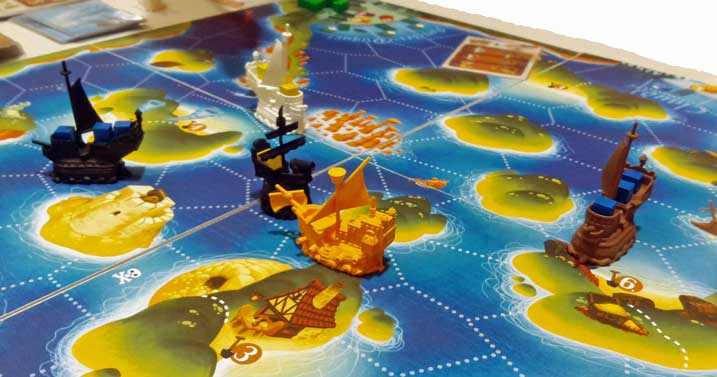
Il Vecchio is a Rüdiger Dorn design, published in 2012 by H@ll Games (Tasty Minstrel Games produce the US edition), but a game that I hadn’t tried. So I was very happy for Chuck to introduce me to it. The board shows Renaissance Tuscany, with the city of Florence in the middle. The surrounding provinces are delineated by roads dotted with towns. Each town can produce a specific resource once players have their workers in place. Resources are then used to buy things that are worth victory points and/or provide some bonus for players.
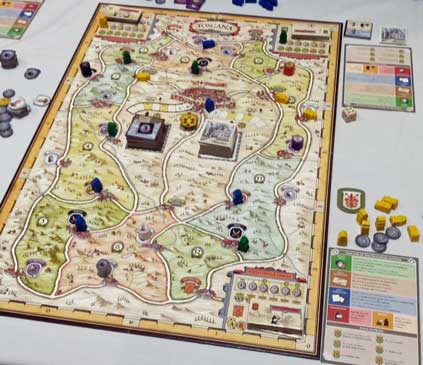
Playing Il Vecchio
Sorry if that description is a little vague, but the detail of the game is about spies and knights and bishops and middlemen and money and other things that boil down to different types of resource that can be used to achieve different things. Do players need to decide what they want to go for and thus which resources they need to collect. Then work out how to collect them most efficiently so that they have more points than their competitors at the end of the game.
The detail provides some nice flavour to the game, as does the evocative artwork, and I thoroughly enjoyed playing it. Il Vecchio is a solid game that I’d be happy to play again, but not one I’d go out of my way to play. I give it a provisional 7/10 on my highly subjective scale.
After another fine curry for dinner, I joined some more old friends, Nick Ramsey and Maryl Fischer, to try Gravwell. I’d only heard of this game because of its Kickstarter campaign advertised on BoardGameGeek, so I was intrigued to find out what all the fuss was about. Designed by Corey Young and published by Cryptozoic Entertainment, the game has players trying to get their spaceships away from a black hole (the gravity well of the title).
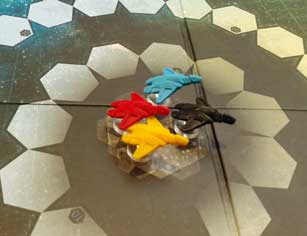
The ships start together in the Gravwell
The board shows a spiral path with the players’ neat spaceship models starting in the middle. A clever drafting mechanism gets the players a hand of cards, which they then play to move their ship. So, everybody selects a card, playing it face down. They are then revealed and actioned in the order of the number on the card. Thus you know what number you’ve played, but not when it will come up in turn order. The twist is that each ship moves towards the nearest object, which could well be backwards!
The result is entertaining chaos as ships move too early or too late and in completely the wrong direction. The first ship to reach the end of the path (escape from the black hole’s gravity) wins the game, of course. Gravwell feels like one of those card games where players have less control than they think they do (6 nimmt being the obvious example), but here with the addition of a board and pieces. I probably won’t be playing it again and it gets a provisional 6/10 on my highly subjective scale.
Casting around for the next game, Nick and I were invited to play Nauticus with Mary Prasad and Aussie games designer Peter Hawes (the game Peter’s currently working on looks interesting, but I didn’t get to play it and the golden rule is not to discuss prototypes). Nauticus is designed by the esteemed duo, Michael Kiesling and Wolfgang Kramer, and published by Kosmos. It’s apparently another game I missed at Spiel last year – I played it twice at the Gathering to make up.
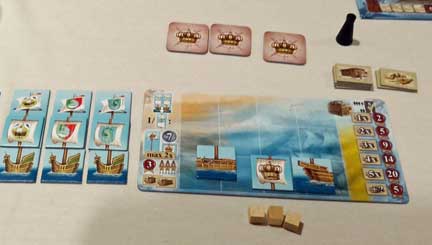
Nauticus ships and warehouse
The idea is that players build ships and transport goods. At the end of the game they will score points for delivered goods (getting more points for more of the same good), but will also get points for their completed ships. The heart of the game is the ingenious mechanism for choosing the next action. In Puerto Rico-style, all players get to do the action, but the player choosing it gets a bonus. Buying actions let players acquire hulls, masts, sails and goods for their ships – some of which they’ll need to store in their warehouse for the time being. Other actions are delivering goods, assembling and loading ships from what’s in your warehouse and generating cash or points.
On top of this, players are limited by the cash and workers they have available, so getting more of those is important. The actions available re-set after seven of the eight have been taken, so turn order is important. The order in which actions are taken can also be crucial, which gives plenty of opportunity for messing with other players. Nauticus is another clever game from Kiesling and Kramer and one I thoroughly enjoyed. I quickly discovered it’s available to play online (at Yucata.de) and signed up for a game. I give it a provisional 9/10 on my highly subjective scale.
Wargames day
The main feature of Saturday morning at the Gathering is the flea market. Lots of people were offering a wide range of games and accessories titles, some of which got me all nostalgic. However, the only thing I picked up was a copy of Falling, James Ernest’s bonkers card game were the object is to be the last player to hit the ground by nudging and deflecting your opponents!
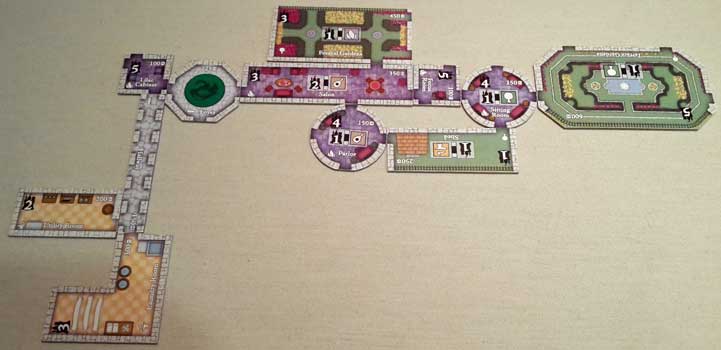
It may not be much, but it’s my castle!
Around the flea market, I caught up with Ted Alspach’s Castles (of Mad King Ludwig). Ted had several pre-production copies available for play and I had been eying it up all week. The main component of the game are cardboard tiles of various shapes representing rooms (and corridors and staircases). As players buy these, they must add them to their castle, which gradually takes shape – and it’s usually a pretty odd shape.
In a very clever mechanism, one player (the master builder) decides the prices of the rooms available that round. The other players buy the rooms they want, paying the master builder for them. The master builder buys last, so is limited to what they’ve been left by the others. Rooms are worth points according to their type and what other types of room they are adjacent to or not.
Castles clearly owes something to Ted’s Suburbia, but plays very differently. Ted’s imprint, Bezier Games, will be launching the game at Spiel this October and I look forward to it. For the time being, it gets a provisional 9/10 on my highly subjective scale.
Another regular on the Gathering timetable in recent years has been an Overlord game of Memoir ’44 run by James and Sheila Davis. This uses two sets of WW2 wargame Memoir ’44 for a large battle scenario with each side having three field generals commanding a section of the battlefield plus a supreme commander. What makes it tricky is that the supreme commander must decide which of his generals should have command cards each turn – though they have a limited ability to act on their own.
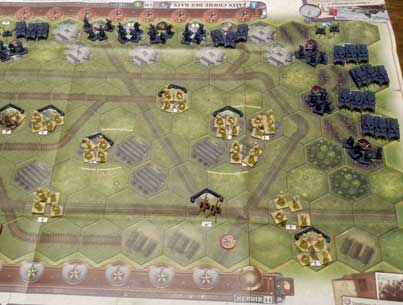
My starting position in the Memoir '44 scenario (above):
infantry dug in to hold off the armour!
This year’s scenario was Rats in a Factory (part of the Battle of Stalingrad), which comes on a printed paper map (thus saving time in setting out the terrain for the battle). Picking at random, I got a Russian and was assigned command of the Russian right flank by comrade Field Marshal Frank di Lorenzo(-vich). This did not look good as I was almost outflanked from the start and had just infantry facing a lot of tanks. On the plus side, the terrain is difficult for tanks and the Russians start with victory medals as they hold the factories that are an objective for both sides.
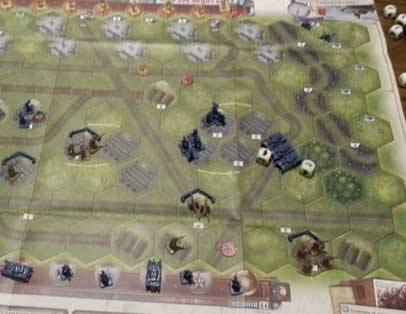
And this is how it finished: not many troops left!
In the event, I was able to hold off my opposing General, Devin Stinchcomb, though my forces took heavy losses and the Russians eventually had to cede control of one factory. James took a pounding in the Russian centre and the Germans nearly broke through at one point. I was able to return some tanks I’d borrowed from James and help see off the attack. With Leo Tischer, on the Russian left flank, making some ground, we managed to get a Russian win, though it was darn close. It’s an odd thing, as a board gamer, to win as a team! There were high fives all round before we remembered our manners and shook hands with the losers our gallant opponents.
Now, I’d been taking some barracking from Leo all through the game – he claimed it was always my flank that crumbled first! So I challenged him to a game of Battle Cry. This is the original game in what is now best known as the “Commands and Colors” series of wargames (including Memoir ’44) designed by Richard Borg. It covers the American Civil War and Leo and I have previous as we’ve played each other several times over the years. This time was a chance to try the second edition of the game, which Hasbro (under their Avalon Hill brand) released a few years ago.
We played one of the scenarios that’s new to the revised edition, the battle of Richmond, Kentucky in 1862. The Confederates won both times we played, but Leo did a better job with the Union I did, to take the win, 11:9 on aggregate. There didn’t seem to be many differences from the original version of the game, apart from artillery units having three pieces instead of two – making them harder to kill. Battle Cry remains a good game – I really should play it more often.
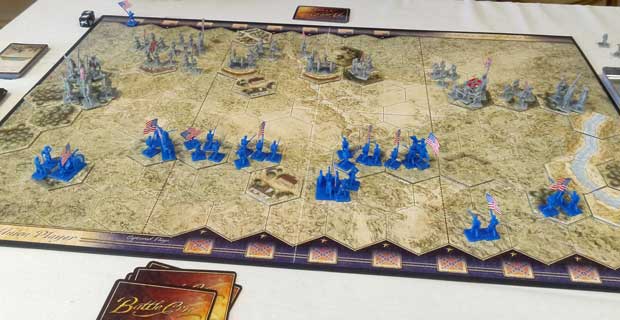
Losing Battle Cry as the Union…
Another fixture of the Gathering is the prize table on Saturday evening. This year, though, we had a new event first: courtesy of Jay Tummelson of Rio Grande Games we had an ice cream social. Free ice cream (and accessories) and the chance to chat: Excellent! But back to the prize table: the idea is that everybody brings a game (of a standard that they would like to receive) and all the games go on the table. After a brief speech and thank yous from Alan Moon, everybody gets to pick something. The winners of the various tournaments held during the week get to choose first and then the rest of us at random. My choice was a copy of Lewis and Clark, another game released last year that I hadn’t played yet (though it as in evidence at the Gathering).
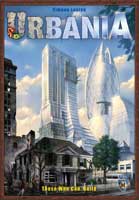 The prizes are pretty much the climax of the Gathering and things start to wind down from the. However, I was enlisted by Walter Hunt to play Urbania, which he described as an excellent game spoiled by terrible graphics. It was also a chance to catch up with another old friend, Joe Huber, who joined us. Jim Fairchild made it four. The square grid of the board is covered in tiles
representing buildings and players will flip these over to represent them being redeveloped.
The prizes are pretty much the climax of the Gathering and things start to wind down from the. However, I was enlisted by Walter Hunt to play Urbania, which he described as an excellent game spoiled by terrible graphics. It was also a chance to catch up with another old friend, Joe Huber, who joined us. Jim Fairchild made it four. The square grid of the board is covered in tiles
representing buildings and players will flip these over to represent them being redeveloped.
To flip buildings, players use cards from their hand, having earlier drawn these from what’s available. They can also draw ‘project’ cards and can keep up to three of these to score extra points at the end of the game. Finally, players can hire a ‘specialist’ to help with their actions. This also increases the value of the specialist, potentially increasing players’ scores at the end of the game.
I enjoyed Urbania, though it is quite abstract – there’s no real feel that you’re re-developing a city. Walter is quite right about the graphic design: it is very busy and confusing, making it difficult to pick out the information you need. That’s a shame as otherwise Simone Luciani has designed an interesting game for Mayfair. It gets a provisional 7/10 on my highly subjective scale.
I finished Saturday evening with a beer or two playing an utterly bonkers game of batting magnetic spaceship pieces about a Crokinole board. The aim being to knock alien pieces and/or pirates into the board’s pockets while avoiding pieces clumping together with their magnets. All I can say is that Benjamin Corliss, who came up with this, is crazy, but it was great fun.
Wrap-up
 Sunday morning was very quiet. Despite being the last official day of the Gathering, many people had already left or were leaving. However, there were more than enough for the traditional final tournament: Can’t Stop. I really enjoy this push-your-luck game and won my first game. I almost had the second one too: needing one more number to win and with two numbers at the top of
their track, I just needed to roll one of them, but the dice deserted me! Ah well, time to go, pausing only for a final round of farewells. And I’m pleased to report that my journey home was uneventful.
Sunday morning was very quiet. Despite being the last official day of the Gathering, many people had already left or were leaving. However, there were more than enough for the traditional final tournament: Can’t Stop. I really enjoy this push-your-luck game and won my first game. I almost had the second one too: needing one more number to win and with two numbers at the top of
their track, I just needed to roll one of them, but the dice deserted me! Ah well, time to go, pausing only for a final round of farewells. And I’m pleased to report that my journey home was uneventful.
Many thanks to Alan Moon and team for all their hard work and I look forward to the next Gathering.
An edited version of this article was published in instalments in To Win Just Once issues 144 and 145 (May and June 2014).
